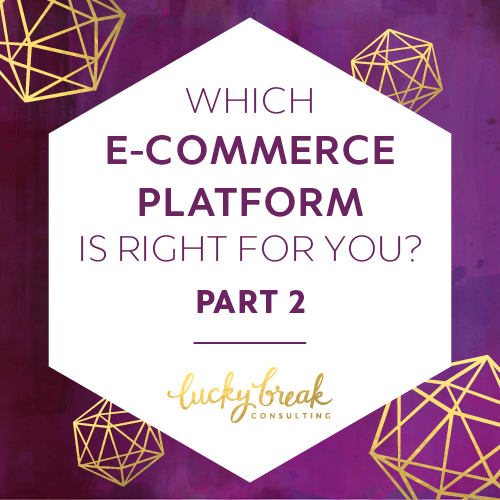
A few weeks ago, I published a blog post which examined some of the most popular e-commerce software systems for product-based brands. That post sparked lots of conversation and spurred more comments than any other post in the history of this blog! As I poured over your comments, I noted a slew of questions about other e-commerce platforms that weren’t included in my original analysis. And lots of you wanted to know which cart I selected for myself and why. So I rang up Padraic Ryan, a web developer that I worked with for 10+ years, and asked for his help in pulling together an analysis of several more platforms that might be of interest.
I invite you to read part one (Which E-Commerce Platform is Right for You?) for a high-level analysis of Wix, WooCommerce, Squarespace, Bigcommerce, and Shopify. In this second and final installment, Padraic and I are tag-teaming to bring clarity to Pinnacle, Spark Pay, Volusion, 3DCart, Magento and Weebly. Padraic also weighs in with some additional thoughts on Shopify and WooCommerce. Grab a mug of something delicious, roll up your sleeves, and let’s get you connected with the shopping cart that best serves your unique business!
SELF-HOSTED CARTS VS. SAAS CARTS
There are actually two umbrellas under which shopping carts fall: self-hosted and SaaS (“software as a service”). I wanted to offer a quick sketch of how each of these work…
SELF-HOSTED CARTS: In this scenario, you purchase the e-commerce software outright. You pay one fee (usually in the hundreds of dollars) and then team up with a developer to bring your site to life. The only ongoing expenses of that cart are:
- An annual fee for your SSL certificate (usually $75-100 per year)
- Hosting fees (usually $20-40 per month)
- Any processing fees your merchant account charges (approximately 3% of all your credit card charges)
The Lucky Break site is actually a self-hosted cart built on the Pinnacle platform and I generally enjoy this software! Working on a self-hosted cart necessitates a larger investment of time and money to get started, but it offers two amazing benefits: a) it’s much less expensive over the lifetime of the cart, and b) I can make this cart do damn near anything I please.
SOFTWARE AS A SERVICE: These carts carry a monthly fee that must be paid on the regular… stop paying and your cart disappears. The beauty of a SaaS cart is that you don’t have to worry about monthly hosting or SSL certificates because everything is rolled into one tidy package that’s managed for you. These carts typically have design templates, too, which means that they’re quicker and easier to launch. With some time and a fair measure of patience, you could technically launch your own SaaS-driven website without tagging in a developer.
And the “add-ons” are often abundant… you can pop plugins galore into a SaaS cart and continue building functionality. The downside to that? Each add-on carries a price tag and they all add up each month. Those prices- regrettably- aren’t locked in either. Once you invest heavily in a SaaS platform, you’re counting on them to keep the pricing of the platform consistent and affordable and that’s not always been the case.
Here’s a quick and dirty comparison of what running $100,000 worth of revenue through the most popular SaaS cart (Shopify) looks like side-by-side with a self-hosted cart like Pinnacle…
PINNACLE CART
Initial cost: +/- $4000 (includes a custom design, not a template)
Monthly Hosting Cost: $35
SSL Certificate: $75/year
Payment Gateway: $30/month
Transaction fees (other than what your gateway charges): $0
First Year cost: $4855
Recurring Yearly cost after the first year: $855
SHOPIFY
Initial Cost: $150 (a premium template from their store)
Monthly Cost: $79
SSL Certificate: $0
Payment Gateway: $30/month
Transaction fees: $500
First Year Cost: $1958
Recurring Yearly Cost after the first year: $1808
Note that above comparison uses the basic Shopify package at $79 a month, which is quite a bit more expensive than the “Basic Shopify” package at $29 per month. Many brands start with the “basic” package and then quickly work their way up in order to access better features.
In the final equation: I recommend either Shopify or Pinnacle for product-based businesses. Which cart you ultimately chose will likely be based on whether you prefer to explore the SaaS or self-hosted route. My vote? Assess your budget, then pick which cart style you like and let that be your guide in selecting the cart. Though there are lots of SaaS and self-hosted options, Pinnacle and Shopify get my “grand prize trophies” in their respective categories.
Prefer SaaS? I vote for Shopify.
Like the idea of a self-hosted cart? I vote for Pinnacle.
In this blog post, I’ve ordered the “pros and cons” section so that my preferred cart from this batch is listed first and the carts become- in my opinion- less desirable the further down this list you go. Without further adieu…
THE PROS AND CONS OF PINNACLE CART
- Extremely flexible: Pinnacle can be programmed to do whatever you want and look however you want.
- Enjoy a large set of core features, including wholesale, abandoned carts, and real-time shipping.
- There are lots of third-party systems already integrated, including: Stamps.com, Endicia, Avalara, Mailchimp.
- There are no or recurring monthly or yearly costs or percentage of sale fees (other than your hosting fees), so this cart ends up being very economical in the long-run.
- You own the software. Even if the company goes out of business, you’ll still be able to run your store.
- PA-DSS compliant, which means that you can accept credit cards directly on your site.
- Pinnacle does require a developer to partner with for the initial setup and design.
- This is a self-hosted cart, which translates to higher “up-front” costs due to the need to hire a developer.
- There aren’t as many available developers from which to choose.
- The default templates aren’t particularly inspiring. You may want to tag in a web designer to develop a custom look. That’s what I did for the Lucky Break site and I’m smitten with the finished product, but it did come with an additional price tag.
- Support is provided through the developer that you choose to partner with. You’ll need to partner with a good developer to enjoy great support.
- There’s a smaller third-party community, which means that there aren’t as many “out of the box” apps and add-on’s available, though a quality developer can make Pinnacle do whatever you like by custom coding on the cart.
Explore Pinnacle. Note: Pinnacle also offers a SaaS version and that’s all you’ll see advertised on their website. Rest assured, though, that they offer self-hosted cart software through a network of handpicked developers.
THE PROS AND CONS OF SPARK PAY
Note: Spark Pay was formerly known as Americommerce. It was recently purchased by financial powerhouse Capital One, who has poured untold millions into fortifying + expanding the platform.
- Spark Pay is a deliciously easy cart to run from the back-end, with intuitive menus, help documents, and fantastic support.
- There are lots of core features, including the ability to run multiple stores from one admin area. This is especially helpful for users who are running one store for wholesale and another for retail.
- Lovely templates from which to choose.
- The fees are very competitive, and they don’t nickel and dime you on fees or change pricing often.
- Spark’s BASE template system is easy to edit using the real-time editor. Changing colors, adding “widgets” to different pages, etc is pretty intuitive. Read here: you won’t need a bottle of tequila to accompany long, late nights of cursing at your website.
- Spark includes a better blogging platform than Shopify, though it’s still not on par with WordPress.
- Fewer third party apps and templates available when compared to Shopify.
- Spark Pay requires a developer to build any features that aren’t available by default, and some areas of the code are restricted.
- You’ll incur additional credit card fees if you use a gateway other than Capital One (which is Spark Pay’s parent company).
Explore Spark Pay, which is a SaaS cart.
THE PROS AND CONS OF MAGENTO
- Another “you can do anything with this cart” type of system. If you can imagine it, it can be done!
- The community version is free, and there’s a large community to help you build your store.
- Enjoy a solid set of core features, and these features work exceptionally well for large, complex product collections.
- You don’t have to worry about price increases since the platform itself is free. You only pay for the cost of hosting, and whatever you pay the developer.
- Regrettably, Magento isn’t a PA-DSS compliant cart, so you’ll need to send your customers off-site to pay or use an Iframe/DPM method.
- The support for this platform is offered by the community, which means support quality varies and nothing is guaranteed.
- Magento must be built in tandem with a savvy developer, and even some developers can’t handle this complex platform.
- If you do want the paid premium version, be prepared to invest $50,000 per year as a minimum. Ouch!
- Upgrading can be extremely costly depending on how much you’ve customized the cart.
Explore Magento, which is a self-hosted cart.
THE PROS AND CONS OF VOLUSION
- Once a top-tier cart, Volusion has lost a lot of ground to Shopify, though it’s still a solid cart. They have some great faceted search functionality for stores with a lot of SKUs.
- Enjoy a strong set of core features.
- 24/7 support is available, and you can usually get a human in 5 minutes or less (can I get an “amen?”).
- There are no transaction fees.
- SSL certificate is not included and will need to be secured at an additional cost ($75-100 per year).
- Volusion templates are starting to look a bit dated, and not many of them are responsive. The ones that are responsive cost more.
- In the absence of a large third-party ecosystem, Volusion offers fewer add-ons and apps.
- There is no blog functionality.
- Volusion’s bandwidth overage charges can get costly quite quickly.
Explore Volusion, which is a SaaS cart.
THE PROS AND CONS OF 3DCART
- There are heaps of standard features, including a built-in registry… which is a rarity.
- Enjoy better pricing when compared to some of its bigger competitors.
- There are a fair number of third-party apps available in 3DCart store.
- Reports of poor service abound- virtually everyone I know has had issues with them at some point.
- The admin interface can be a bit clunky, and the cart has a “cluttered” feel to it.
- The 3DCart templates are due for a major overhaul, and there aren’t as many to choose from when compared to Shopify or some of the other big carts.
- 3D Cart simply hasn’t kept up with the times.
Explore 3DCart, which is a SaaS cart.
THE PROS AND CONS OF WEEBLY
- Weebly is super easy to use… even a tech-challenged user can manage their “drag + drop” web builder.
- Delightfully inexpensive.
- The templates are repsonsive, so they display well on smart phones and tablets.
- If you don’t need advanced features and are happy with their default templates, then this might be an acceptable basic cart.
- Unfortunately, there’s not much flexibility to be had. And by “not much flexibility to be had,” I really mean “no flexibility at all.” You get what you get. If you’d like to customize the templates beyond color/font or move things around, then you’re simply out of luck.
- Many advanced features for design and functionality are absent, and they can’t be added.
- The native blog functionality is pretty paltry and there’s no possibility of plugging a WordPress blog into the site.
Explore Weebly, which is a SaaS cart.
CARTS TO AVOID AT ALL COSTS
X-CART: Once the industry leader, this platform simply hasn’t kept up with the times. It’s buggy, the support is poor, the templates are dated, and it’s not PA-DSS compliant.
ECWID: Billed as a plug-in you can use on any site, this software is built by X-Cart. That alone should be sufficient to cause a dash for the hills.
OSCOMMERCE: One of the first carts, this “freeware” cart should be avoided. It simply isn’t secure enough to run a modern e-commerce store.
YAHOO STORES: This dying platform isn’t a wise investment of time + resources.
BIG CARTEL: This is a simple, basic cart with a minimal feature set. It was designed for artists with catalogs of no more than 300 SKUs. Because it lacks many of the key core functions, Big Cartel isn’t flexible or robust enough for modern e-commerce stores.
MIVA MERCHANT: One of the original e-commerce companies, Miva has re-invented itself countless times. They’ve always had great set of core features, but this cart isn’t easy to work with and there are few templates from which to choose. Miva also has the potential to become extremely expensive. Last year, Miva introduced a new pricing structure that caused some people to go from $60/month to $1500/month. That’s not something you want to risk with your business!
Padraic took a peek at my first blog in this series and he wanted to offer these further thoughts on a few of the platforms I explored.
ADDITIONAL THOUGHTS ABOUT SHOPIFY
- Shopify has no built-in wholesale functionality. If you want to offer different products, shipping or payment methods to wholesale buyers, then you’ll need to explore some “workaround” methods. This Aeolidia blog offers a nice list of possibilities.
ADDITIONAL THOUGHTS ABOUT WOOCOMMERCE
- WordPress and Woo recently merged companies, so eventually they’ll merge the platform into one robust CSM/E-Commerce Platform… that’s an exciting possibility, but we’re not there quite yet.
- WordPress requires constant updates as security holes are found, since it’s the most-hacked platform on the planet. The more add-ons and apps you have tied into the platform, the more difficult these regular updates become. If one app developer doesn’t update their app when the platform is upgraded, it can bring down your whole system. For that reason, WooCommerce requires more work than I think it’s worth. Most Lucky Break clients don’t have the mental energy available to remain this alert and vigilant.
- WooCommerce isn’t a PA-DSS complaint cart, which means that you can’t accept credit cards directly on the site. This limits your options, as you’ll need to either send the customer off-site to pay or use a compliant gateway like Braintree.
- You’ll definitely want to partner with a developer in order to maintain the hosting and constant upgrades. This isn’t something a non-tech person should try to manage themselves.
Have cart questions? I’d love for you to pop a comment below… I’ll do my best to help!





Avoid ZenCart too! Ain’t nobody got time for that!!
What is written about X-Cart is simply a lie. First, X-Cart Payments is PA-DSS _certified_ which is better than just compatible. Second, their technical support is superior to what you get from Magento Enterprise at $18K/yr, believe me. They solve problems, not just send you instructions. Third, their templates are modern and look good on mobile.
Please correct the article as long as you want to supply your readers with reliable information. Not this bs.
PS: Yes, I am a big fan of X-Cart and use them for my business for more than 4 years. As a long term user I can say – X-Cart is the best what could happen to me. I thank the Lord for it every day.
Well, hello there Gregg… nice to meet you! I’m pretty familiar with XCart and stand by the article. I’ve asked Padraic, my web developer (and a former XCart developer) to weigh in. I’m sure he’ll be along shortly. 😉
Hi Gregg, I developed on X-Cart for over 10 years and built over 300 carts with it. I was also the forum moderator for years with over 30k posts (screen name ‘balinor’ if you want to check me out), so let’s just say I’m pretty familiar with both the cart and the company behind it. I also used to be a big fan, but that is no longer the case. Here’s why.
First, X-Cart by default is not PA-DSS compliant. You need to purchase an X-Payments subscription to make it compatible, and the prices on that start at $49.95/month. If you have a busy store, that price jumps to almost $200/month. In addition, it adds a step to the checkout process, which breaks the golden rule of checkout optimization. The more steps, the more cart abandonment. Quite simply, something that adds a step to the checkout and also charges you additional fees to use it is not a smart solution.
Next, let’s talk about tech support. Sure, they provide tech support, but you have to pay for it. $99 per incident if you don’t mind waiting a day to get a response due to the time difference. Want a response quicker? That will cost you $139. But wait, they offer a subscription plan for support too – that will only set you back $149/month. Doesn’t matter if you don’t have any tickets that month, they still get your money. Sorry, but that isn’t tech support, that is highway robbery. Most modern carts offer free tech support (i.e. Shopify, Spark Pay, etc). I can’t speak to Magento Enterprise, (which is more like $50k/year), nor did the article compare X-Cart to it.
Finally, if you do happen to go in the forums, you’ll notice the best third party vendor recently closed shop. Why? Because in the last few of years third party sales have dropped by over 75%. That is never a good sign for a cart company, and the reason is very simple – it is no longer a top-tier platform. From a design and functionality standpoint, the cart is dated. The new version of X-Cart actually has far fewer features than the old version. If you look at the templates available on a cart like Shopify vs the ones on X-Cart, there is just no comparison. Any designer worth their salt would wholeheartedly agree with me.
Not only are people leaving X-Cart, they are leaving X-Cart in huge numbers. I’ve migrated over 200 sites myself. Don’t get me wrong, it used to be a fantastic cart, but they haven’t kept up with the times and have made some poor business decisions in the last 3 years. Unless they turn things around, they simply won’t be around in another 3.
I’m glad that X-Cart works well for you and you are happy with them, but you are most definitely in the minority here. I fully support Lela’s recommendation to avoid it.
Hi Padraic, thanks for the comment. I used Shopify for more than a year before I moved to X-Cart and I can say – it’s nothing compared in terms of features and flexibility. Their support was good but since the platform is limited in features and cant be customized, you dont need much of assistance usually. And when you need, their help is limited to some instructions.
Magento Enterprise was used for another store in a company I used to work before launching my own business. They paid for the first tier of Enterprise something like $15K/year and never got anyone from Magento having a look at their bugs. These included a critical bug of Magento itself which was not fixed for more than a year. It’s hardly to imagine something like that at X-Cart. I feel that everyone I contact goes an extra mile to help me. It’s amazing. Nothing to complaint about.
I paid them like 4K to start (included software, x-payments, several add-ons, template and some custom mods applied). Now I am on their Enhanced hosting plan which already include cart support. So I am all set at $200/month. It’s not much for an operating business here in US. And it’s definitely compared to an HOUR of US based engineer.
What’s your hour price, by the way?
Hi Gregg,
I appreciate that you’ve found a solution you’re pleased with. I’ve also had an XCart site since 2006 and stand by what’s reflected both in the original blog post and in the subsequent comments offered by both Padraic and I. Neither Padraic nor I recommend Magento, so that’s a bit tangential. It didn’t make our “avoid at all costs” list but it didn’t earn a ringing endorsement either.
In the final equation, it sounds like you’ll continue using and loving XCart and more power to you. I can’t recommend it for my clients, though I know nothing about your business and respect your decision to choose any cart you like. Best wishes!
I’m currently on Shopify. Sales were good, now they’re dead. 🙁
I’m so glad I’ve found a course that understands the nightmares and enjoyments off being a creativepreneur! I’m ready to learn what’s needed to grow my AWESOME products and help the world Discover the Dead Sea Difference! Wink, wink! 🙂
Thanks Lela for all you do!
I would so love to see an updated version of this.. current carts have been upgraded, there are new contenders….
Hi Marge,
I’ve periodically updated portions of this blog series as recently as late this summer. My latest opinion is this: Shopify reigns supreme for virtually every product-based brand that I work alongside! Everything else is an incredibly distant second. I hope that helps!